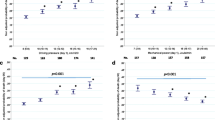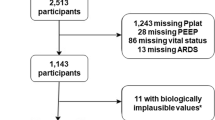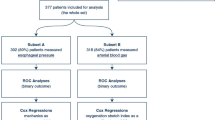Abstract
Objective
The aim of this prospective longitudinal study was to compare driving pressure and absolute PaO2/FiO2 ratio in determining the best positive end-expiratory pressure (PEEP) level.
Patients and methods
In 122 patients with acute respiratory distress syndrome, PEEP was increased until plateau pressure reached 30 cmH2O at constant tidal volume, then decreased at 15-min intervals, to 15, 10, and 5 cmH2O. The best PEEP by PaO2/FiO2 ratio (PEEPO2) was defined as the highest PaO2/FiO2 ratio obtained, and the best PEEP by driving pressure (PEEPDP) as the lowest driving pressure. The difference between the best PEEP levels was compared to a non-inferiority margin of 1.5 cmH2O.
Main results
The best mean PEEPO2 value was 11.9 ± 4.7 cmH2O compared to 10.6 ± 4.1 cmH2O for the best PEEPDP: mean difference = 1.3 cmH2O (95% confidence interval [95% CI], 0.4–2.3; one-tailed P value, 0.36). Only 46 PEEP levels were the same with the two methods (37.7%; 95% CI 29.6–46.5). PEEP level was ≥ 15 cmH2O in 61 (50%) patients with PEEPO2 and 39 (32%) patients with PEEPDP (P = 0.001).
Conclusion
Depending on the method chosen, the best PEEP level varies. The best PEEPDP level is lower than the best PEEPO2 level. Computing driving pressure is simple, faster and less invasive than measuring PaO2. However, our results do not demonstrate that one method deserves preference over the other in terms of patient outcome.
Clinical trial number: #ACTRN12618000554268. Registered 13 April 2018.
Similar content being viewed by others
Introduction
During acute respiratory distress syndrome (ARDS), lung function is similar to a functional baby lung [1]. Optimal ventilatory parameter adjustment is crucial in ARDS [1,2,3]. A low tidal volume (Vt) has been proven to decrease mortality [4]. However, the optimal level of positive end-expiratory pressure (PEEP) is still matter of controversies [4]. Several methods have been proposed to select the best PEEP level [5, 6], which varied according to the method used. This point may explain the discrepancies across studies comparing high and low PEEP level [2, 7]. Oxygenation based on ARDS Network PEEP/FiO2 table [4] or absolute PaO2/FiO2 ratio is often used to adjust PEEP (PEEPO2) [3, 5,6,7,8,9,10,11]. The PEEP titration on oxygenation gives different results depending on whether one uses PEEP/FiO2 table or the absolute PaO2/FiO2 ratio.
Driving pressure (DP), computed as plateau pressure (Pplat) minus PEEP, reflects the stress and strain applied to the lung [12]. Lower DP values may be strongly associated with survival [12]. For a given PEEP level, the change in DP is more related to mortality than the change in PaO2/FiO2 ratio [13]. The best PEEPDP is higher compared to the best PEEP determined by the PEEP/FiO2 table [5, 6], but lower when PEEP was determined by absolute PaO2/FiO2 ratio [14, 15]. A recent study showed that the direction of PEEP change needed to reduce DP was variable from values given in the PEEP/FiO2 table [9]. Finally, it is difficult to assume that the PEEP value determined by DP will be higher or lower than that determined by absolute PaO2/FiO2 ratio.
Our objective here was to compare the value of the best PEEP level using DP (PEEPDP) or absolute PaO2/FiO2 ratio after a decremental PEEP trial.
Patients and methods
The study protocol was approved by the Ouest IV-Nantes CPP (IRCB # 2018-A01760-55). Informed consent was provided from the patients or relatives. The DROP study (DRiving pressure for Optimization of Positive end-expiratory pressure) was registered on the Australian New Zealand Clinical Trials Registry (#ACTRN12618000554268. Registered 13 April 2018).
Between November 2018 and June 2019, we prospectively included 122 consecutive patients with moderate or severe ARDS as previously defined [16]. Exclusion criteria were age younger than 15 years, chest tube with persistent air leak, and hemodynamic instability.
Patients received neuromuscular blocking agents and volume-controlled ventilation with Vt set at 6 mL/kg of predicted body weight, FiO2 at 1, inspiratory/expiratory ratio at 1:2, and respiratory rate at 30/min for a Pplat ≤ 30 cmH2O. All patients were in supine position. PEEP was increased until Pplat reached 30 cmH2O at constant Vt then decreased at 15-min intervals, to 15, 10, and 5 cmH2O. No recruitment maneuver was used and Vt was not reduced during and after PEEP trial. FiO2 was set at 1 in order to standardize circumstances [11] and because PaO2/FiO2 ratio is influenced if FiO2 varies greatly. Arterial blood gases were analyzed and lung mechanics recorded after each step. Mean arterial pressure was also collected. The best PEEPO2 was defined as a > 10% difference in PaO2/FiO2 ratio between two consecutive PEEP reduction (this value was defined "a priori" and was based on a previous study [11]), and the PEEP value before this one was considered to be optimal PEEP. The best PEEPDP was defined as the PEEP associated with the lowest DP without knowing the best PEEPO2 level.
Continuous variables were described as mean ± SD and compared using Student’s t-test if normally distributed and described as median [interquartile range] otherwise. Dichotomous variables were compared by applying the Chi-square test or McNemar’s test. Repeatedly measured quantitative variables were analyzed by ANOVA. To test whether the best mean PEEPDP was not inferior to the best mean PEEPO2, with a non-inferiority margin set at 1.5 cmH2O and assuming a best PEEP of 10 cmH2O with a standard deviation of 3.5 cmH2O, 118 patients were required. The margin > 1.5 cmH2O was retained because some authors decrease the PEEP level by 2 cmH2O during the PEEP trial, which appears to be significant [9, 15].
Results
Table 1 reports the main features of the 122 patients. Table 2 summarizes respiratory mechanics and gas exchanges. Mean arterial pressure did not change significantly across PEEP levels (P = 0.71). At a Pplat = 30 cmH2O, the PEEP maximal was 17.0 ± 2.3 cmH2O. Median auto-PEEP was 1 [IQR 0–1] cmH2O. The best mean PEEPO2 was 11.9 ± 4.5 cmH2O compared to 10.6 ± 4.1 cmH2O for the best PEEPDP: mean difference = 1.3 cmH2O (95% confidence interval [95% CI], 0.4–2.3; one-tailed P value, 0.36). Only 46 PEEP levels were the same with the two methods (37.7%; 95% CI 29.6–46.5). The distribution of the best PEEP levels differed significantly between the two methods (P = 0.025) (Fig. 1).
Mean differences for PaO2/FiO2 ratio between best PEEPO2 and best PEEPDP were 26.4 [95% CI 17.6–35.0] mmHg (P < 0.0001); 1.2 [95% CI 0.9–1.5] cmH2O for DP (P < 0.0001); 2.4 [95% CI 1.3–3.5] cmH2O for Pplat (P < 0.0001); and − 6.3 [95% CI − 8.6 to − 3.9] mL/mmHg for respiratory system compliance (P < 0.0001). DP was above 14 cmH2O in 18 (14.7%) patients with PEEPO2 compared to 1 (0.08%) patient by PEEPDP (P = 0.06). Pplat was 30 cmH2O in 29 (23.8%) patients titrated by PEEPO2 compared to 13 (10.6%) patients titrated by PEEPDP (P = 0.007).
Discussion
Using absolute PaO2/FiO2 ratio or DP in PEEP titration resulted in different best PEEP levels. PEEP level and DP value were higher with PEEPO2, which resulted in a larger number of patients having PEEP levels ≥ 15 cmH2O. It should be noted that all PEEP titrations were performed in supine position and that these results cannot be extrapolated in prone position [6].
PaO2 may imperfectly reflect alveolar recruitment. Thus, alveolar recruitment correlates poorly with oxygenation, as this last results from complex interactions between lung function and hemodynamics [10, 17]. Due to the abnormal behavior of poorly aerated lung tissue, increased recruitment may fail to improve oxygenation [1]. We did not use the PEEP/FiO2 table [4] because it does not target the PEEP level to individual lung mechanics. Contrary to previous studies based on PEEP/FiO2 table, the best PEEP based on absolute PaO2/FiO2 ratio was higher than that based on DP as previously reported [5, 6]. In our study, the improvement of PaO2/FiO2 ratio with increase PEEP was mild. The larger number of patients with PEEP ≥ 15 cmH2O when oxygenation method was used raises concern about potential hyperinflation, even when Pplat remains lower than 30 cmH2O [7, 18]. Therefore, the oxygenation method may not reliably protect against ventilation-induced lung injury [9, 18]. Thus, some patients were probably at risk for overdistension injury, even while receiving PEEP according to the PEEP/FiO2 table [9]. Improved oxygenation after a PEEP increase is barely associated with lower mortality [10, 13].
DP may depend mainly on lung mechanics [12]. Measuring DP at different PEEP levels provides information on the balance between hyperinflation and opening-closing during tidal ventilation [5, 7, 14]. At a constant Vt, PEEP titration based on DP is equivalent to titration based on respiratory system compliance [5, 7, 14]. PEEP increments may be protective only when the increased PEEP values for a same Vt result in a lower DP [12]. In contrast, a DP increase when PEEP is raised indicates a decrease in respiratory compliance, suggesting hyperinflation due to the higher PEEP [7].
Higher survival was observed among patients with lower DP, independent of concomitant variations in PEEP and Pplat [12]. Interestingly, DP is more strongly associated with survival than oxygenation, even after adjustment to Vt [13]. The difference in DP values obtained by PEEPO2 or PEEPDP may seem small but it has been suggested that each 1 cmH2O increase in DP was associated with a fourfold higher mortality risk [19]. However, oddly enough, the personalized PEEP approach with recruitment maneuver used in the ART trial lowered DP but increased mortality [20].
Our study has limitations. Firstly, the study population was very specific: 60% of patients with ARDS were admitted after thromboendarterectomy and lung transplantation. This does not represent the typical ARDS patients’ category in most ICUs. Secondly, the PEEP effect was tested in the very short term, but DP stabilized within a few minutes of PEEP titration [9]. Thirdly, Vt was left at 6 ml/kg predicted body weight and was not normalized to functional lung size based on lung elastance. However, such approach could minimize bias. Fourthly, we did not use recruitment maneuver, which can influence the PEEP trial, but could also affect mortality [20]. Fifthly, change in DP, as a surrogate for change in transpulmonary pressure, may not be appropriate in patients with extremely low chest wall or abdominal compliance. Finally, the effects of the different PEEP levels on the lung parenchyma were not studied, and we did not record variations of cardiac output.
In conclusion, depending on the method chosen, the best PEEP level varies. The best PEEP level based on DP is lower than that based on oxygenation. Computing DP is simple, faster, and less invasive than measuring PaO2. However, despite some previous studies arguing for adjusting the PEEP on DP, our results do not demonstrate that one method deserves preference over the other in terms of patient outcome.
Availability of data and materials
The datasets used and/or analyzed during the current study are available from the corresponding author on reasonable request.
References
Gattinoni L, Marini JJ, Pesenti A, et al. The “baby lung” became an adult. Intensive Care Med. 2016;42:663–73.
Fan E, Del Sorbo L, Goligher EC, et al. An Official American Thoracic Society/European Society of Intensive Care Medicine/Society of Critical Care Medicine Clinical Practice Guideline: mechanical ventilation in adult patients with acute respiratory distress syndrome. Am J Respir Crit Care Med. 2017;195:1253–63.
Pelosi P, Ball L, Barbas CSV, et al. Personalized mechanical ventilation in acute respiratory distress syndrome. Crit Care. 2021;25:250.
Acute Respiratory Distress Syndrome Network, Brower RG, Matthay MA, et al. Ventilation with lower tidal volumes as compared with traditional tidal volumes for acute lung injury and the acute respiratory distress syndrome. N Engl J Med. 2000;342:1301–8.
Valentini R, Aquino-Esperanza J, Bonelli I, et al. Gas exchange and lung mechanics in patients with acute respiratory distress syndrome: comparison of three different strategies of positive end expiratory pressure selection. J Crit Care. 2015;30:334–40.
Boesing C, Graf PT, Schmitt F, et al. Effects of different positive end-expiratory pressure titration strategies during prone positioning in patients with acute respiratory distress syndrome: a prospective interventional study. Crit Care. 2022;26:82.
Sahetya SK, Goligher EC, Brower RG. Fifty years of research in ARDS. Setting positive end-expiratory pressure in acute respiratory distress syndrome. Am J Respir Crit Care Med. 2017;195:1429–38.
Chiumello D, Cressoni M, Carlesso E, et al. Bedside selection of positive end-expiratory pressure in mild, moderate, and severe acute respiratory distress syndrome. Crit Care Med. 2014;42:252–64.
Sahetya SK, Hager DN, Stephens RS, Needham DM, Brower RG. PEEP Titration to Minimize Driving Pressure in Subjects With ARDS: A Prospective Physiological Study. Respir Care. 2020;65:583–9.
Goligher EC, Kavanagh BP, Rubenfeld GD, et al. Oxygenation response to positive end-expiratory pressure predicts mortality in acute respiratory distress syndrome. A secondary analysis of the LOVS and ExPress trials. Am J Respir Crit Care Med. 2014;190:70–6.
Toth I, Leiner T, Mikor A, Szakmany T, Bogar L, Molnar Z. Hemodynamic and respiratory changes during lung recruitment and descending optimal positive end-expiratory pressure titration in patients with acute respiratory distress syndrome. Crit Care Med. 2007;35:787–93.
Amato MBP, Meade MO, Slutsky AS, et al. Driving pressure and survival in the acute respiratory distress syndrome. N Engl J Med. 2015;372:747–55.
Suter PM, Fairley B, Isenberg MD. Optimum end-expiratory airway pressure in patients with acute pulmonary failure. N Engl J Med. 1975;292:284–9.
Huang Y, Yang Y, Chen Q, et al. Pulmonary acute respiratory distress syndrome: positive end-expiratory pressure titration needs stress index. J Surg Res. 2013;185:347–52.
ARDS Definition Task Force, Ranieri VM, Rubenfeld GD, et al. Acute respiratory distress syndrome: the Berlin Definition. JAMA. 2012;307:2526–33.
Karbing DS, Panigada M, Bottino N, et al. Changes in shunt, ventilation/perfusion mismatch, and lung aeration with PEEP in patients with ARDS: a prospective single-arm interventional study. Crit Care. 2020;24:111.
Terragni PP, Rosboch G, Tealdi A, et al. Tidal hyperinflation during low tidal volume ventilation in acute respiratory distress syndrome. Am J Respir Crit Care Med. 2007;175:160–6.
Costa ELV, Slutsky AS, Brochard LJ, et al. Ventilatory Variables and Mechanical Power in Patients with Acute Respiratory Distress Syndrome. Am J Respir Crit Care Med. 2021;204:303–11.
Writing Group for the Alveolar Recruitment for Acute Respiratory Distress Syndrome Trial (ART) Investigators, Cavalcanti AB, Suzumura ÉA, et al. Effect of lung recruitment and titrated positive end-expiratory pressure (PEEP) vs low PEEP on mortality in patients with acute respiratory distress syndrome: a randomized clinical trial. JAMA. 2017;318:1335–45.
Funding
This work was supported solely by institutional and/or departmental sources.
Author information
Authors and Affiliations
Contributions
SRD participated in designing the study, collecting and analyzing the data, and drafting the manuscript; LR contributed to design the study, to collect and analyze the data, and to review the manuscript; AG contributed to collect, analyze the data, and to review the manuscript; CR contributed to collect, analyze, interpret the data, and to review the manuscript; TG contributed to collect, analyze, and interpret the data and to draft the manuscript; FS conducted the literature review, design of the study, analyze and interpret the data and draft the manuscript. All authors approved the final version and agreed to be accountable for all aspects of the work in ensuring that questions related to the accuracy or integrity of any part of the work are appropriately investigated and resolved.
Corresponding author
Ethics declarations
Ethics approval and consent to participate
The study protocol was approved by the Ouest IV-Nantes CPP (IRCB # 2018-A01760-55). Informed consent was provided from the patients or relatives. The DROP study (DRiving pressure for Optimization of Positive end-expiratory pressure) was registered on the Australian New Zealand Clinical Trials Registry (#ACTRN12618000554268).
Consent for publication
Not applicable.
Competing interests
The authors declare that they have no competing interests.
Additional information
Publisher's Note
Springer Nature remains neutral with regard to jurisdictional claims in published maps and institutional affiliations.
Rights and permissions
Open Access This article is licensed under a Creative Commons Attribution 4.0 International License, which permits use, sharing, adaptation, distribution and reproduction in any medium or format, as long as you give appropriate credit to the original author(s) and the source, provide a link to the Creative Commons licence, and indicate if changes were made. The images or other third party material in this article are included in the article's Creative Commons licence, unless indicated otherwise in a credit line to the material. If material is not included in the article's Creative Commons licence and your intended use is not permitted by statutory regulation or exceeds the permitted use, you will need to obtain permission directly from the copyright holder. To view a copy of this licence, visit http://creativecommons.org/licenses/by/4.0/. The Creative Commons Public Domain Dedication waiver (http://creativecommons.org/publicdomain/zero/1.0/) applies to the data made available in this article, unless otherwise stated in a credit line to the data.
About this article
Cite this article
Rezaiguia-Delclaux, S., Ren, L., Gruner, A. et al. Oxygenation versus driving pressure for determining the best positive end-expiratory pressure in acute respiratory distress syndrome. Crit Care 26, 214 (2022). https://doi.org/10.1186/s13054-022-04084-z
Received:
Accepted:
Published:
DOI: https://doi.org/10.1186/s13054-022-04084-z





